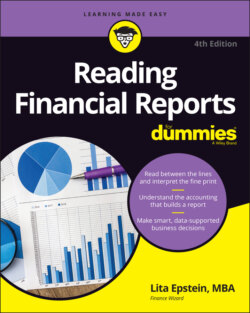Читать книгу Reading Financial Reports For Dummies - Lita Epstein - Страница 3
Reading Financial Reports For Dummies® To view this book's Cheat Sheet, simply go to www.dummies.com and search for “Reading Financial Reports For Dummies Cheat Sheet” in the Search box. Table of Contents
Оглавление1 Cover
4 Introduction About This Book Conventions Used in This Book What You're Not to Read Foolish Assumptions Icons Used in This Book Beyond the Book Where to Go from Here
5 Part 1: Getting Started with Financial Reports Chapter 1: Opening the Cornucopia of Reports Figuring Out Financial Reporting Checking Out Types of Reporting Dissecting the Annual Report to Shareholders Chapter 2: Recognizing Business Types and Their Tax Rules Flying Solo: Sole Proprietorships Joining Forces: Partnerships Seeking Protection with Limited Liability Companies Shielding Your Assets: S and C Corporations Chapter 3: Public or Private: How Company Structure Affects the Books Investigating Private Companies Understanding Public Companies Filing and More Filing: Government and Shareholder Reports Entering a Whole New World: How a Company Goes from Private to Public Chapter 4: Digging into Accounting Basics Making Sense of Accounting Methods Understanding Debits and Credits Checking Out the Chart of Accounts Differentiating Profit Types
6 Part 2: The Big Show: Annual Reports Chapter 5: Exploring the Anatomy of an Annual Report Everything but the Numbers Presenting the Financial Picture Summarizing the Financial Data Chapter 6: Balancing Assets against Liabilities and Equity Understanding the Balance Equation Introducing the Balance Sheet Ogling Assets Looking at Liabilities Navigating the Equity Maze Chapter 7: Using the Income Statement Introducing the Income Statement Delving into the Tricky Business of Revenues Acknowledging Expenses Sorting Out the Profit and Loss Types Calculating Earnings per Share Chapter 8: The Statement of Cash Flows Digging into the Statement of Cash Flows Checking Out Operating Activities Investigating Investing Activities Understanding Financing Activities Recognizing the Special Line Items Adding It All Up Chapter 9: Scouring the Notes to the Financial Statements Deciphering the Small Print Accounting Policies Note: Laying out the Rules of the Road Figuring out Financial Borrowings and Other Commitments Mergers and Acquisitions: Finding Noteworthy Information Pondering Pension and Retirement Benefits Breaking Down Business Breakdowns Reviewing Significant Events Finding the Red Flags Chapter 10: Considering Consolidated Financial Statements Getting a Grip on Consolidation Looking at Methods of Buying Up Companies Reading Consolidated Financial Statements Looking to the Notes
7 Part 3: Analyzing the Numbers Chapter 11: Testing the Profits and Market Value The Price/Earnings Ratio The Dividend Payout Ratio Return on Sales Return on Assets Return on Equity The Big Three: Margins Chapter 12: Looking at Liquidity Finding the Current Ratio Determining the Quick Ratio Investigating the Interest Coverage Ratio Comparing Debt to Shareholders’ Equity Determining Debt-to-Capital Ratio Chapter 13: Making Sure the Company Has Cash to Carry On Measuring Income Success Checking Out Debt Calculating Cash Flow Coverage
8 Part 4: How Companies Optimize Operations Chapter 14: Turning Up Clues in Turnover and Assets Exploring Inventory Valuation Methods Applying Three Inventory Valuation Methods Determining Inventory Turnover Investigating Fixed Assets Turnover Tracking Total Asset Turnover Chapter 15: Examining Cash Inflow and Outflow Assessing Accounts Receivable Turnover Taking a Close Look at Customer Accounts Finding the Accounts Payable Ratio Determining the Number of Days in Accounts Payable Deciding Whether Discount Offers Make Good Financial Sense Chapter 16: How Companies Keep the Cash Flowing Slowing Bill Payments Speeding Up Collecting Accounts Receivables Borrowing on Receivables Reducing Inventory Getting Cash More Quickly
9 Part 5: The Many Ways Companies Answer to Others Chapter 17: How Companies Find Errors: The Auditing Process Inspecting Audits and Auditors Examining Records: The Role of the Auditor Filling the GAAP Chapter 18: Government Regulations and Reporting Requirements Checking Out the 10-Q Introducing the 10-K Investigating Internal Controls Uncovering the Ways Companies Keep in Compliance Digging into Board Operations Finding Out about Insider Ownership Chapter 19: Creating a Global Financial Reporting Standard Why Develop a Worldwide Financial Standard? Key Moves to Reshape Global Financial Reporting Who Benefits from a Global Standard and How? Key Differences between GAAP and IFRS Chapter 20: Understanding the Analyst–Corporation Connection Typecasting the Analysts Regarding Bond-Rating Agencies Delving into Stock Rating Taking a Look at How Companies Talk to Analysts Chapter 21: How Companies Communicate with Shareholders Making the Most of Meetings Checking Out How the Board Runs the Company Sorting through Reports Catching Up on Corporate Actions Culling Information from Analyst Calls Staying Up-to-Date Using Company Websites Regarding Reinvestment Plans Chapter 22: Keeping Score When Companies Play Games with Numbers Getting to the Bottom of Creative Accounting Unearthing the Games Played with Earnings Exploring Exploitations of Expenses Finding Funny Business in Assets and Liabilities Playing Detective with Cash Flow
10 Part 6: The Part of Tens Chapter 23: Ten Financial Scandals That Rocked the World Enron Madoff Citigroup Adelphia WorldCom/MCI Tyco Waste Management Bristol-Myers Squibb Halliburton Arthur Andersen Chapter 24: Ten Signs That a Company's in Trouble Lower Liquidity Low Cash Flow Disappearing Profit Margins Revenue Game Playing Too Much Debt Unrealistic Values for Assets and Liabilities A Change in Accounting Methods Questionable Mergers and Acquisitions Slow Inventory Turnover Slow-Paying Customers
11 Glossary
12 Index
